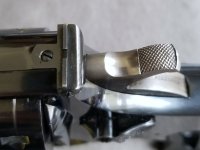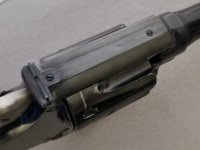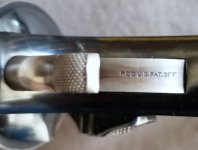This turned out to be a very helpful link, Thank You. I compared with the pics from that sale, and to me at least it looks similar, albeit with a little more "life experience". Close s/n to the one in the link.I take it that there is no SN available at present. This has some pictures of a first model from a past sale. The second Model, K-22/40, has a micrometer rear sight. Scarce, Early Smith & Wesson K-22 Outdoorsman - 1st Model | Legacy Collectibles. Expand the picture to see a good view of the first model rear sight. First models are much more common than K-22/40s.
I really can't even guess at the correctness of the sights, but they look at least similar, with one elevation adjustment screw (no set screw), a tiny windage adjustment screw, a rear sight leaf fitted into the top strap, Patridge-type front blade. Whatever it is, definitely NOT the rare Second Model (not a Masterpiece), but one can hope a K-22 First Model with all correct parts. It may also need a new sear spring or something like that, because it does not work in double action, only single.
Taking good pics of both sides without reflections or shadows will require better light, but I am working on that. (The milky area around the rear sideplate screw is a ceiling reflection)

The serial numbers I can see all match (frame, barrel, cylinder), and the assembly numbers on the frame and yoke also.
Attachments
Last edited:









